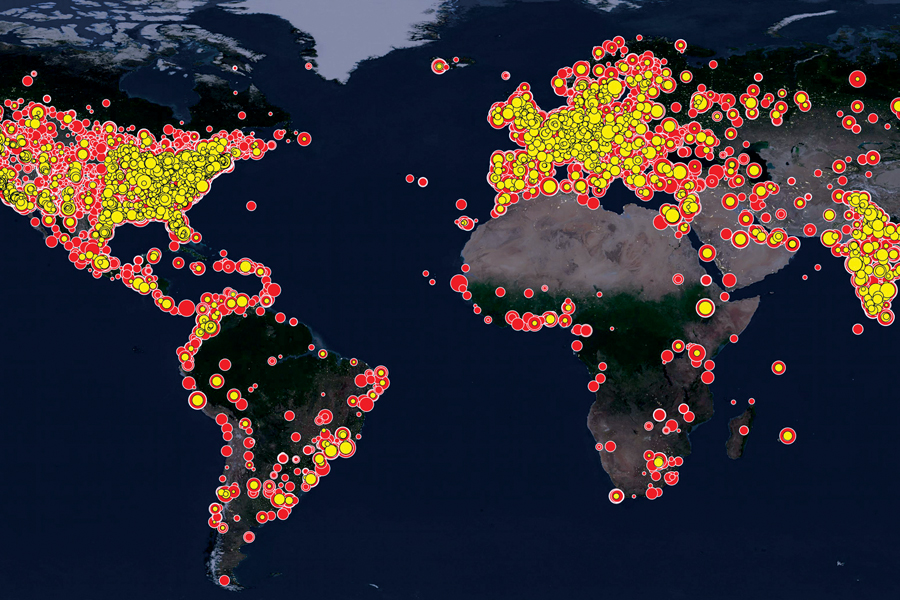Progress, however, has been slowed by the lack of collaboration. Research papers eventually appear, but the cited experiments are often difficult to reproduce. Meanwhile, the number of nanoelectronics graduates is insufficient to meet the potential demand.
On a website called nanoHUB housed on a cluster of computers at Purdue, an alternative, more collaborative, nanoelectronics future is emerging. Thousands of researchers, students, educators and industrial practitioners around the world are simultaneously running nanoelectronics experiments; visualizing data; and sharing simulations, tools and techniques.
nanoHUB has become the world’s premier online portal for nanoelectronics research and education. It is now expanding into additional areas, such as nanomanufacturing and nano-bio applications, in partnerships with the University of Illinois and Indiana University. The portal will be used for simulations and visualizations of interactions that occur below the threshold of human sight and on the edge of human understanding.

Under the direction of Gerhard Klimeck, Reilly Director of the Center for Predictive Materials and Devices and the director of the National Science Foundation-funded Network for Computational Nanotechnology (NCN), which oversees the project, nanoHUB offers free browser-based control of more than 500 simulation tools and over 5,500 other content items used by nearly 1.4 million academics and students annually. Approximately 1,800 contributors from 172 countries have stocked the site with new tools and educational materials, including 100 classroom courses with 5,000 lectures and tutorials offered via a nanoHUB-U program.
nanoHUB is “like a nano-app store where you don’t have to download apps because they run inside your browser,” explains Klimeck, a professor of electrical and computer engineering. “It provides access to a Linux-based computational engine via a virtual desktop.”
Approximately 90 to 95 percent of nanoHUB users are academic, and the rest are industrial, says Klimeck. “The projects include computational research, concrete experimental research, fundamental education and what-if experiments,” he says. “The industrial users don’t usually tell us what they’re doing. Companies that are worried about IP will never run anything IP sensitive on a public resource. There’s a lot of apprehension about doing that in the cloud.”
The nanoHUB middleware, which is brought to life by a HUBzero website development program, integrates a nanoVIS 3D visualization platform and a Rappture GUI and data management platform. Most of the contributors’ tools run on Purdue computer clusters of about 40 nodes. Some, however, require the use of a supercomputer. “We can dispatch big jobs to supercomputers, such as the Texas Advanced Computing Center, so users don’t need accounts,” says Klimeck.
The applications that require a supercomputer include nine tools that use a NEMO simulation engine that Klimeck developed with the help of researchers at his Nanoelectronic Modeling Group. The NEMO tools are among the most advanced of the nanoHUB applications, enabling atomic-resolution calculation of nanostructure properties. The latest NEMO5 release offers the unprecedented capability to combine electron flow and structure modeling in one, two and three dimensions for electrons, photons and thermal flow.
Klimeck’s group contributes simulation tools, research seminars, support tools and educational materials to the project. However, the NEMO research is kept separate from his continuing development of nanoHUB.
A Backstory With Some PUNCH
nanoHUB evolved from a Purdue project launched in the mid-1990s by Mark Lundstrom, the Don and Carol Scifres Distinguished Professor of Electrical and Computer Engineering, called PUNCH. In 1998, this online hub for simulating micro and nanoelectronics was reborn as nanoHUB, and in 2002, the NSF funded a major expansion. Lundstrom engaged Klimeck in nanoHUB’s vision during the proposal writing and lured Klimeck back to Purdue from NASA to become nanoHUB’s technical director.
Largest Online Nanotechnology Resource
- 500+ Simulation Tools
- ~1.4M Users
- 5,500+ Resources
- 1,800 contributors from 172 countries
- 5,000 lectures and tutorials
The portal is built on an open-source website development platform for the nanotechnology community. In 2007, Purdue helped Klimeck spin off the technology as a platform called HUBzero, designed for a wider set of use cases. HUBzero is designed for sites like nanoHUB that need to host analytical tools, publish data, share resources, collaborate, and build communities. Today HUBzero is a business unit inside ITaP, which created a HUBzero Software Foundation and operates more than 30 HUBs for other communities.
“One of our breakthroughs with HUBzero is that if you already have a Linux-based simulation tool with a small GUI, written in languages like Matlab, C or python, we can deploy it on nanoHUB within a day,” says Klimeck. nanoHUB users without a GUI can use the Rappture platform, which “allows for the creation of relatively simple but usable GUIs and data management. Within a few weeks you can have a viable tool wrapped around some script that would otherwise be impossible to use.”
Researchers can publish their nanoHUB simulation tools on their own and retain ownership. Most users, however, permit others to study and use them, and some are completely open source. “nanoHUB’s tools are as valuable as research papers — if not more so — because you can duplicate the results from the papers,” says Klimeck. “We have created a new class of publications: tools that have scientific merit.”
Skeptics questioned whether nanoHUB code could effectively be shared by others. As the site expanded, Klimeck was able to prove them wrong.
“I plowed through the nanoelectronics literature to identify citations and secondary citations to nanoHUB and was able to demonstrate that researchers do indeed use other researchers’ code for their own research,” says Klimeck. “Web of Science approached us three years ago and began listing us as a proper citation, and then Google Scholar followed suit.”
Today, almost 2,000 papers have been published with nanoHUB citations, and there have been more than 30,900 secondary citations, with an overall h-index of 82. Web of Science and Google Scholar recognize nanoHUB tools and compact models as proper publications, building nanoHUB’s reputation as a publisher of tools, says Klimeck. This in turn provides incentives for researchers to publish their tools as proper publications.

A Blueprint for Science and Technology Education
Klimeck also encountered skepticism that nanoHUB could be an effective classroom teaching tool. Yet today, more than 35,100 students in 1,780 classes at 185 institutions use nanoHUB systematically in formalized education.
nanoHUB stands out from other nanotech educational tools by enabling the assembly of animated image sequences that are highly effective at explaining complex nanoscale interactions. Another key benefit is that students can work with the same cutting-edge tools used by researchers.
“The rate of adoption is fast — the median time between when a tool is first published on nanoHUB and the first-time use in classrooms is less than six months,” says Klimeck. “When you compare that with reading a textbook that took three to four years to produce, you can see that we’re on the forefront of innovating education.”
nanoHUB’s combination of visualizations, accessibility and timeliness has been a hit with students, and will likely encourage more of them to commit their careers to the challenging field. The site’s open-ended approach to education provides a blueprint for other scientific and technical disciplines looking to boost their ranks.
In five years, the NSF will ramp down the funding of nanoHUB’s national infrastructure, says Klimeck. He’s now looking at multiple potential strategies to move forward. “First, we could sell almost commercial-level software support and disseminate it through nanoHUB,” he explains. “If we can grow instructional use of nanoHUB in formalized education, we could also explore a subscription-like service similar to professional societies who publish articles.”
Meanwhile, nanoHUB continues to break down the barriers between nanoelectronics researchers around the world. “nanoHUB is a self-service platform where anybody can deploy their code,” says Klimeck. “That’s a key breakthrough in computational science.”

